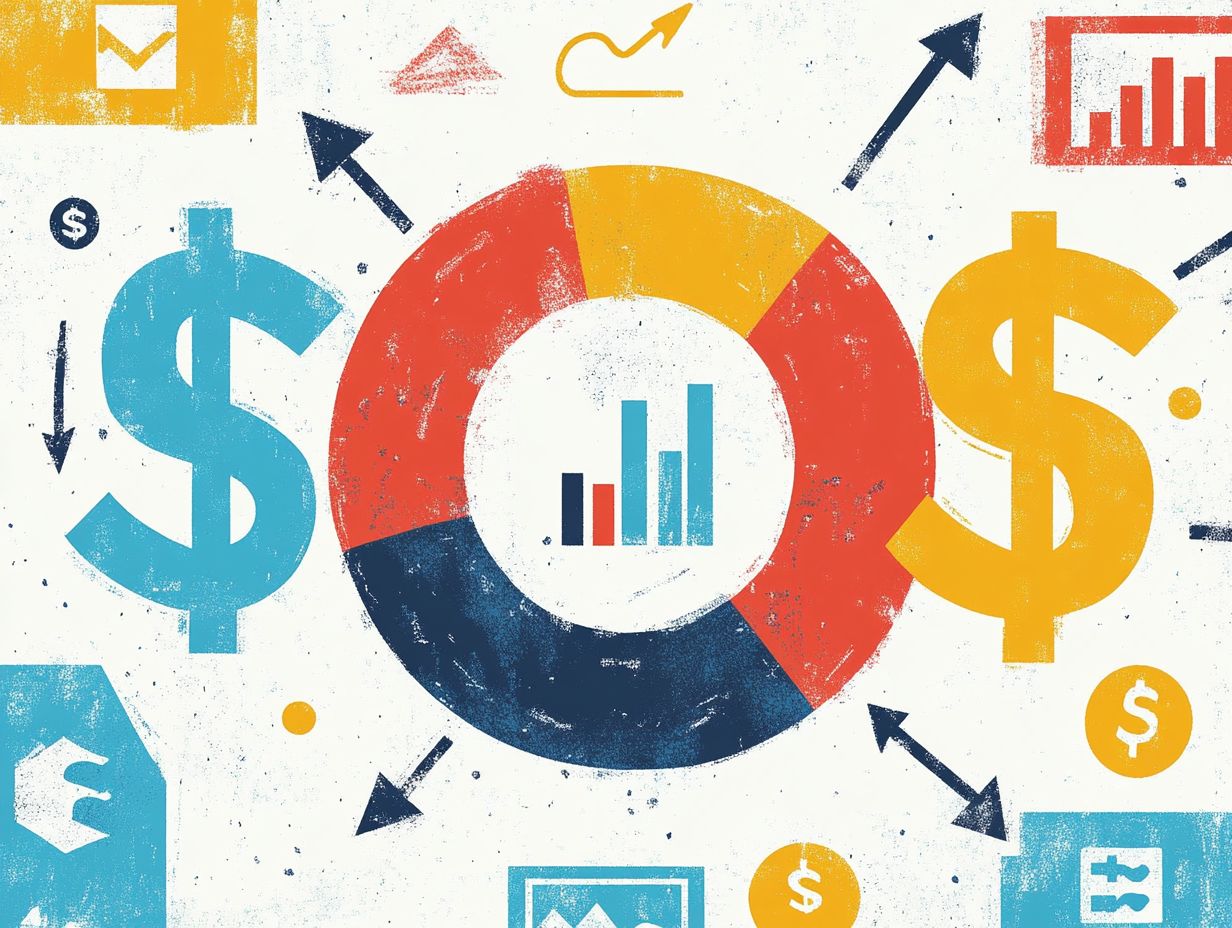What Are Stock Market Cycles?
Understanding stock market cycles is essential for you as an investor seeking to make informed decisions.
These cycles, marked by four distinct stages Accumulation, Mark Up, Distribution, and Mark Down illustrate the natural ebb and flow of market activity, shaped by factors such as economic conditions, investor sentiment, and corporate earnings.
This article will guide you through each stage, delve into the key influences, and offer insights on how to effectively identify and track these cycles using technical analysis tools and market indicators.
Immerse yourself to elevate your investment strategy!
Contents
Key Takeaways:

- Stock market cycles show the ups and downs of the market, influenced by economic factors and how investors feel.
- Knowing the four stages accumulation, markup, distribution, and markdown guides you in making smart buying and selling decisions.
- Use technical analysis tools to track these cycles and anticipate market movements for strategic investments.
Understanding Stock Market Cycles
Understanding stock market cycles is crucial for you as an investor aiming to make informed financial decisions and successfully navigate the intricate landscape of financial markets. These cycles represent the recurring phases that the stock market experiences, shaped by various factors such as economic conditions, investor sentiment, and market trends.
Recognizing these cycles empowers you to align your strategies and seize market opportunities! This enhances your potential for lucrative investments while allowing for more effective investment distribution as you work toward achieving your long-term financial goals.
Definition and Explanation
A market cycle encompasses the natural fluctuations in the stock market, featuring four distinct phases: accumulation, markup, distribution, and markdown. Grasping this concept is essential whether you re a seasoned investor or just stepping into the trading arena.
In the accumulation phase, astute investors begin to buy undervalued stocks, nurturing optimism that nudges prices upward. As the cycle transitions into the markup phase, enthusiasm builds, leading to a substantial rise in stock prices, fueled by increased demand and uplifting market sentiment.
When the distribution phase kicks in, the atmosphere shifts. Early investors may cash in on their gains, creating selling pressure that can spiral into the markdown phase, where prices dip as negativity influences investor behavior.
The Four Stages of a Stock Market Cycle
The stock market cycle unfolds in four distinct stages: the accumulation phase, markup phase, distribution phase, and markdown phase. Each stage reveals unique market characteristics and investor emotions.
By grasping these phases, you can refine your strategies, adapting to the ever-changing market conditions that sway stock prices and overall market health. Each stage carries its own investor sentiment and behavioral patterns, which play a crucial role in guiding your financial decisions and risk management.
These insights can significantly impact your portfolio’s performance.
Accumulation
The accumulation phase represents the initial stage of the stock market cycle, where you, as an informed investor, begin to buy undervalued stocks, anticipating future growth.
During this pivotal period, you might employ various strategies to take advantage of perceived market inefficiencies. Both individual and institutional investors exhibit a cautious yet optimistic demeanor, focusing on companies with strong fundamentals that have the potential for recovery. The enthusiasm of these early adopters often leads to gradual increases in stock prices, fostering a healthy market environment. As more savvy participants recognize the attractive pricing, momentum builds, setting the stage for the forthcoming markup phase.
Thus, the accumulation phase establishes a robust foundation for future price appreciation, signaling a shift in market sentiment toward optimism.
Mark Up

The markup phase follows the accumulation stage. It is marked by rising stock prices and heightened investor confidence as market trends turn positive.
During this phase, various economic indicators like improved employment rates and increased consumer spending contribute to a more favorable market environment. Investor sentiment becomes a driving force that pushes stocks higher. Enthusiasm often leads to greater trading volumes, driving prices up.
As optimism fills the market, you ll need to reassess your investment strategies, leaning toward growth stocks that promise substantial returns. This positive feedback loop encourages further investment, creating a cycle that boosts upward momentum and shapes the broader market landscape.
Distribution
During the distribution phase, stock prices peak, prompting investors to start selling off shares in anticipation of a market downturn.
As this shift in investor behavior unfolds, sentiment often stirs the pot of volatility, making market fluctuations more pronounced. Many individuals, driven by the fear of losing potential gains, begin to reassess their financial decisions and risk management strategies.
This introspection may push you to adopt a more cautious approach, weighing the risks of holding onto overvalued assets against the prospect of future returns. The collective actions of investors prioritizing capital preservation over aggressive growth can significantly shift market dynamics.
This creates a cascading effect that impacts prices and investor confidence.
Mark Down
The markdown phase unfolds with declining stock prices and a palpable sense of investor anxiety as fears of a market downturn take center stage.
During this intense period, emotions may swing from panic to disbelief, often leading to hasty decisions.
This emotional turbulence shakes your portfolio and creates ripple effects across the broader economic landscape. As stocks continue to slide, you’ll likely need to reassess your risk tolerance and investment strategies, weighing the options of cutting losses or seizing potential bargains.
This phase shows just how important it is to have strong strategies to manage risks and strategic foresight, pushing you to navigate a landscape filled with uncertainty.
Factors that Influence Stock Market Cycles
A multitude of factors influences stock market cycles, including economic conditions, investor sentiment, and company profits. Each element plays a crucial role in shaping market trends and overall performance.
Understanding this interplay provides invaluable insights as you navigate the complexities of the market.
Economic Conditions
Economic conditions, such as GDP growth and interest rates, are critical in shaping the stock market, influencing investor sentiment and overall market vitality.
For instance, when GDP rises, it often signals increased corporate profits, attracting investment and driving stock prices higher. If interest rates climb, borrowing costs increase, leading to reduced consumer spending and potentially stunting market growth.
Many savvy investors keep a close eye on these indicators to refine their strategies. During economic expansions, growth stocks might catch their interest, while downturns could lead them to favor more defensive investments.
Fluctuations in unemployment rates and inflation can also indicate shifts in market cycles, prompting traders to adjust their portfolios as needed.
Investor Sentiment

Investor sentiment plays a pivotal role in shaping stock market cycles. Your emotional responses to market fluctuations can trigger significant changes in your behavior.
This human tendency often leads to impulsive reactions, resulting in widespread buying or selling that can amplify market trends. Historical examples, such as the dot-com bubble of the late 1990s and the housing market crash of 2007-2008, illustrate how collective emotions can ignite rapid price surges followed by sharp declines.
During these wild market swings, emotions like optimism and fear can drive investor decisions. Understanding these cycles can empower you to navigate the financial landscape with greater confidence.
Corporate Earnings
Corporate earnings reports are crucial market signals that significantly impact stock prices and investor behavior.
These reports reveal a company s financial health and future growth prospects, which shape investor sentiment and expectations. When earnings exceed forecasts, optimism often surges, driving stock prices up and potentially starting a bull market.
Conversely, disappointing earnings can trigger sell-offs and cultivate negative sentiment, causing declines across the market. This connection between earnings and stock fluctuations highlights the importance of analyzing financial performance.
As an investor, your goal is to seize emerging opportunities or mitigate risks in a constantly changing financial landscape.
How to Identify and Track Stock Market Cycles
Identifying and tracking stock market cycles requires leveraging various methods to analyze stock price movements and market indicators. These resources provide valuable insights into emerging trends and investor behavior, helping you navigate market complexities.
Technical Analysis Tools
Technical analysis tools, like moving averages and trend lines, are essential for identifying stock market cycles and understanding price trends.
Investors often use these tools to assess the momentum of securities, allowing them to spot critical market signals. For instance, moving averages smooth out price fluctuations, providing a clearer view of overall trends, while trend lines mark important support and resistance levels.
Oscillators and volume indicators also provide insights into potential reversals or continuations. By combining these methods, you can make informed decisions and navigate the trading landscape with confidence.
Market Indicators to Watch
Key market indicators, such as the Dow Jones Industrial Average and various economic metrics, offer essential insights for tracking stock market cycles and understanding investor behavior.
Monitoring these signals helps gauge overall economic health and forecast trends. For example, shifts in unemployment rates or changes in consumer spending patterns may indicate important changes in market sentiment.
Recognizing correlations among various indicators enables you, as an investor or analyst, to make informed decisions, whether it s identifying promising investment opportunities or adjusting your risk exposure. Understanding the relationship between interest rates and stock performance offers a more nuanced perspective on market dynamics and aids you in crafting a robust financial strategy.
Frequently Asked Questions

What Are Stock Market Cycles?
Stock market cycles refer to the repeating patterns of growth and decline in stock market prices over a certain period. These cycles are influenced by various economic, social, and political factors.
How long do stock market cycles typically last?
Stock market cycles have no fixed duration. Some may last a few months, while others can extend for several years.
Remember, past performance doesn t guarantee future results.
What are the different stages of a stock market cycle?
Stock market cycles consist of four main stages: expansion, peak, contraction, and trough. In the expansion stage, stock prices rise, reaching a peak before they decline.
The contraction stage sees falling prices, followed by the trough, which is the lowest point before a new cycle starts.
How can investors benefit from stock market cycles?
Investors can capitalize on stock market cycles by recognizing patterns. Buying stocks during troughs, when prices are low, and selling at peaks can lead to great profits.
Are stock market cycles predictable?
There are trends in stock market cycles, but they’re not completely predictable. Unexpected events and changes in policies or global conditions can alter the cycle’s direction.
How can investors protect themselves during a stock market downturn?
To shield themselves during downturns, investors should diversify their portfolios. Consider investing in resilient assets, like bonds or real estate, which can hold value when markets fall.






